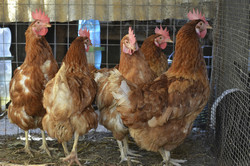Debugging poultry in Europe
A consortium of 10 institutions, the CAMCON(opens in new window) (Campylobacter control - novel approaches in primary poultry production) project had input from seven European countries. They examined causative risk factors for bacterial transmission and colonisation and determined effective methods to prevent or treat such contamination in poultry. Significant milestones were achieved by the CAMCON consortium. Several study farms with broiler chickens were set up across Europe and over 100 flocks of chickens were tested for contamination. Unfortunately, over 50 % tested positive for Campylobacter contamination and no farm was consistently Campylobacter-free. Multilocus sequence typing (MLST) of Campylobacter jejuni in Norway, Poland and Spain helped assess the spread of bacterial sub-types on a geographic basis. An interesting finding is the similarity in Campylobacter MLST types found in flies and broilers. Study outcomes led to the realisation of a pilot study at two farms to assess the efficacy of fly screens. Results revealed the need for basic biosecurity along with implementation of fly screens. Project partners also tested the effectiveness of pre-harvest interventions in preventing Campylobacter contamination using techniques such as phage therapy and vaccination. Except for in ovo vaccination of embryonated chicken eggs, no promising interventions were found. For monitoring broiler flocks and detecting contamination, techniques such as air sampling, particle-size profiling and boot sock sampling were used by CAMCON partners. A comparison of techniques revealed that air sampling is the most cost-effective method for Campylobacter detection using filters coupled with quantitative polymerase chain reaction (qPCR). CAMCON has also provided guidance on producing Campylobacter-free chickens through illustrated biosecurity folders, slide presentations and posters, design of an essential biosecurity check list as well as suitable web-based educational programmes. CAMCON has amassed enough data for a certification programme for broiler producers and retailers to produce broilers with low risk of Campylobacter contamination. Project outcomes were disseminated via several scientific publications, posters and presentations at scientific meetings as well as the poultry industry internationally and nationally. Successful reduction in the incidence of human infections from chicken contamination with Campylobacter could also be applied to free-range birds and other animals in the future. This has huge implications for the competitiveness of the poultry industry in Europe and the safety of EU citizens.



